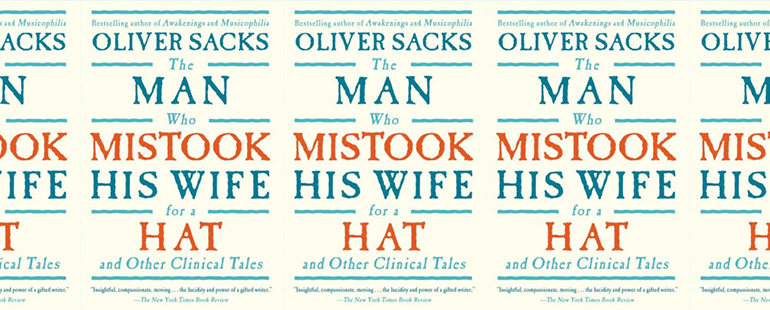Oliver Sacks’ Whole-Person Approach

Over the course of his career, neurologist and author Oliver Sacks published over a dozen books that brought the mysteries and marvels of the human mind to a general audience. One of the most well-known, his 1985 book, The Man Who Mistook His Wife for a Hat and Other Clinical Tales, contains twenty-four case studies centering on people for whom brain injury or illness has led to symptoms so strange as to be almost inexplicable. When telling these stories, Sacks is clinical insofar as he understands and can convey the importance of medical diagnosis, but he is also deeply compassionate in his approach. His dual perspective allows him to see both patient and person, and treatment is never the end of the story for him. Instead, Sacks affirms time and time again the need to look at a whole person, not just someone’s symptoms, in order to help them truly heal.
Sacks opens The Man Who Mistook His Wife for a Hat with the titular case, in which a patient, codenamed Dr. P., comes to see Sacks because of vision problems that may be neurological in nature. Sacks exams Dr. P. and discovers that he has a few minor abnormalities with his left-side reflexes, and, more significantly, that he is unable to tell the difference between his foot and his shoe. Sacks observes Dr. P. looking “not at the shoe, with an intense but misplaced concentration. Finally his gaze settled on his foot: ‘This is my shoe, yes? . . . [he] put a hand to his foot.” Sacks is unable to account for this confusion but continues his examination. Later, when it’s time for Dr. P. to leave, he “reached out his hand and took hold of his wife’s head, tried to lift it off, to put it on. He had apparently mistaken his wife for a hat! His wife looked as if she was used to such things.” At this point, Sacks is both intrigued and concerned, and proposes more testing to see what the cause of Dr. P.’s difficulties might be.
When Sacks investigates further, he uncovers additional instances of Dr. P.’s visual dysfunctions. Presented with photos of friends, family, even of himself, he is unable to recognize anyone. Given a rose or a glove, he cannot identify them by sight. Having gathered sufficient data, Sacks postulates that Dr. P. likely has either “a massive tumour or degenerative process in the visual parts of his brain” leading to a situation in which “the visualisation of faces and scenes, of visual narrative and drama—this was profoundly impaired, almost absent.” This diagnosis is the most Sacks can offer Dr. P. His symptoms are consistent with a disorder, prosopagnosia, also known as “face blindness,” for which there are no accepted treatments even today, but Sacks, however, does not actually go on to offer this medical opinion to Dr. P. Instead, he makes quite a different suggestion, one in line with what he knows of Dr. P as a person.
Despite his visual symptoms, Dr. P. is a musician of considerable skill and a professor at a local university. Upon meeting him, Sacks had found Dr. P. to be “a man of great cultivation and charm, who talked well and fluently, with imagination and humour.” After testing, Sacks wondered how Dr. P. was able to continue teaching at such a high level despite his compromised vision. The answer to this question is supplied in part by Dr. P.’s wife. She tells Sacks that Dr. P. “sings all the time—eating songs, dressing songs, bathing songs, everything. He can’t do anything unless he makes it a song.” This information leads Sacks to theorize that “music, for him, had taken the place of image. He had no body-image, he had body music: this is why he could move and act as fluently as he did.” It is a remarkable example of Dr. P.’s unconscious adaptability, and it leads Sacks to not leave Dr. P. with an incurable medical diagnosis, but instead to ‘prescribe, in a case such as yours, is a life which consists entirely of music. Music has been the center, now make it the whole, of your life.’” With this proposed treatment, Sacks tacitly acknowledges the limits of medicine in Dr. P.’s case as well as the fact that Dr. P.’s personal strengths have already allowed him to manage his symptoms as well as could be.
Another case Sacks presents is that of Ray, a man diagnosed with Tourette syndrome. This disorder is “characterised by an excess of nervous energy . . . tics, jerks, mannerisms, grimaces, noises, curses, involuntary imitations and compulsions of all sorts.” Ray was “almost incapacitated by multiple tics of extreme violence coming in volleys every few seconds.” He had experienced such symptoms for most of his life, and at the age of twenty-four had only strained personal relationships as well as trouble maintaining stable employment. After hearing Ray’s account, Sacks prescribes him Haldol, an antipsychotic medication, as treatment. After some initial trial and error, Ray “found himself tic-free, but without significant ill-effects—and he has remained this way for the past nine years.” This may seem like a miracle of what was then modern medicine, and it might be if there were nothing more to Ray than symptoms.
While taking Haldol, Ray was able to live a relatively stable and happy life, but he was also “less sharp, less quick in repartee, no longer bubbling with witty tics or ticcy wit . . . . He has lost his obscenities, his coarse chutzpah, his spunk. He had come to feel, increasingly, that something [was] missing.” Before treatment, Ray had been a “weekend jazz drummer of real virtuosity, famous for his sudden and wild extemporisations.” After beginning to take Haldol, however, he was no longer capable of such musicianship, and he mourned the loss. Despite successfully managing his symptoms, Ray made the decision to “take Haldol ‘dutifully’ throughout the working week, but would take himself off it, and ‘let fly’, at weekends.” While the medicine was healing in many ways for Ray, it was not enough for him as someone with a life beyond his diagnosis. Ray’s story, and Sacks’ supportive telling of it, reinforces the notion that people are complicated and require more than an absence of illness to be happy.
A later case in The Man Who Mistook His Wife for a Hat concerns a nineteen-year-old woman named Rebecca who has a congenital condition that causes “gross perceptual and spatio-temporal problems, and gross impairments in every schematic capacity—she could not count change, the simplest calculations defeated her, she could never learn to read or write.” In her case, the diagnosis may be relatively straightforward, but the challenge of treatment is perhaps even more complex. Sacks and his team do their best by assigning Rebecca to “a variety of workshops and classes, as part of [their] Developmental and Cognitive Drive,” but this course of action “didn’t work with Rebecca.” Sacks further admits that “it didn’t work with most of them. It was not, I came to think, the right thing to do, because what we did was to drive them full-tilt upon their limitations.” For Rebecca and others with similar conditions, treatment designed to get them to a “normal” level of function could only fail because such interventions did not take into account that their abilities and joy might lie elsewhere.
In Rebecca’s case, when Sacks sees her with “human, as opposed to my neurological, vision,” she is “coherent, intelligible, poetic, whole.” Despite not being able to read, Rebecca loves stories and Sacks observes her to be “complete and intact as ‘narrative’ being, in conditions which allowed her to organise herself in a narrative way.” Rebecca herself is eventually able to declare, “I want no more classes, no more workshops . . . . They do nothing for me. They do nothing to bring me together.” Instead, Sacks and his team are able to enroll Rebecca in a theater group, and Sacks feels that, “if one sees Rebecca on stage . . . one would never even guess that she was mentally defective.” In this case, Rebecca herself was able to direct her treatment toward positive ends, and her story offers a particularly strong example of what medical care can and can’t do for patients, as well as the need to look beyond prescriptive interventions for options that truly fit the needs of the person.
Sacks’ sympathy for his patients is clear throughout The Man Who Mistook His Wife for a Hat, but there are moments in Rebecca’s story and others where his antiquated language is jarring. Sacks sometimes refers to Rebecca as “an idiot,” and such vernacular is no longer accepted. Sacks, however, is both of and beyond his time. His use of such terms is a sign of how common this vocabulary was thirty-five years ago, but the empathy and respect he shows his patients is very much in line with person-centered and strengths-based practices that have become increasingly available in recent years. In this way, Sacks was once again able to transcend medical limits to better support those in his care.


